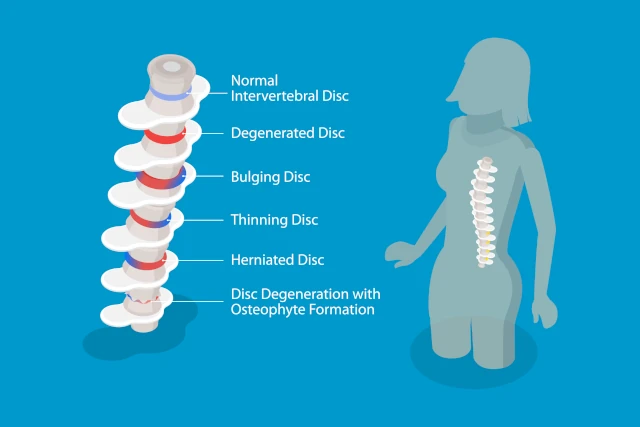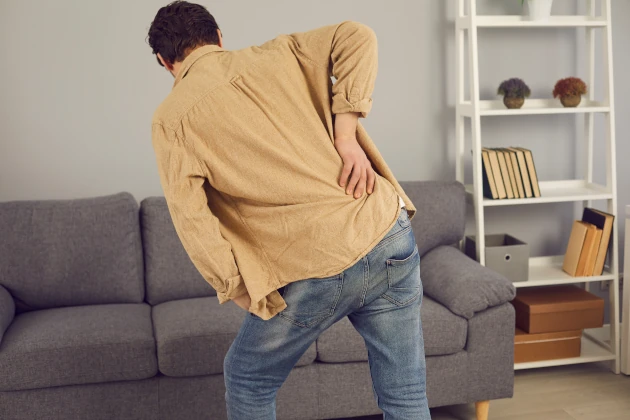
Spinal Disc Problems Explained: 9 Types, MRI vs X-Ray, Symptoms & Physiotherapy Rehab
- Dr. Sonali Bansal (MPT)
Connect with our expert physiotherapist for personalized physiotherapy advice.
Introduction
Spinal disc issues are one of the most common causes of chronic back pain, sciatica, and neck stiffness. From bulging discs to sequestered fragments, each condition needs a unique approach to diagnosis, treatment, and physiotherapy rehabilitation.
This updated guide to disc problems covers:- All 9 disc pathologies (including rare types like Schmorl’s nodes)
- Red-flag symptoms requiring urgent medical attention
- MRI vs. X-ray – which scan works best?
- Proven physiotherapy exercises for each disc issue
- When disc surgery becomes necessary
The 9 Types of Spinal Disc Problems
Bulging Disc
- Description: Disc expands evenly beyond its normal boundary (like a hamburger patty too big for its bun).
- Common Symptoms: Dull, achy lower back pain or neck stiffness, occasional tingling or numbness.
- Physiotherapy Rehab: Core stabilization (dead bugs, planks), posture correction (ergonomic assessments).
Herniated Disc (Slipped Disc)
- Description: The outer layer (annulus fibrosus) tears, allowing the nucleus pulposus to leak.
- Symptoms: Sciatica, muscle weakness, foot drop, tingling.
- Rehab: McKenzie back extensions, nerve flossing exercises.
Degenerative Disc Disease (DDD)
- Description: Disc dehydrates and shrinks over time (like a dried-out sponge).
- Symptoms: Chronic stiffness, bone spurs, disc space narrowing.
- Rehab: Low-impact cardio (swimming, cycling), flexion-based stretches.
Disc Protrusion
- Description: A localized disc bulge presses on nerves without leakage of inner material.
- Rehab: Spinal traction therapy, core-focused exercises.
Disc Extrusion
- Description: Nucleus leaks but remains connected to the disc.
- Risks: High chance of nerve compression.
- Treatment: Epidural steroid injections, physiotherapy.
Sequestered Disc Fragment
- Description: Disc fragment breaks off and floats inside the spinal canal.
- Red Flags: Cauda equina syndrome, groin numbness, bladder/bowel issues.
- Emergency Treatment: Immediate microdiscectomy surgery.
Annular Tear
- Description: Small tear in the outer disc layer.
- Symptoms: Sharp, localized back pain.
- Rehab: Rotation stretches, lumbar/core strengthening.
Schmorl’s Nodes
- Description: Disc material herniates vertically into adjacent vertebrae.
- Note: Often painless and found on X-rays.
Spinal Stenosis with Disc Collapse
- Description: Collapsing disc narrows the spinal canal, compressing nerves.
- Symptoms: Leg pain when walking, relieved by rest.
- Rehab: Flexion-based exercises, hip/glute strengthening.
Diagnosis: How Doctors Identify Disc Issues
| Test | Best For | Limitations |
|---|---|---|
| MRI | Soft tissue, nerve root & disc details | Expensive, may trigger claustrophobia |
| X-ray | Bony alignment, vertebral slippage | Doesn’t show disc soft tissues |
| CT Scan | Bone spurs, vertebral fractures | Radiation exposure |
Treatment Options for Disc Problems
Non-Surgical Treatments
- Physiotherapy: Core strengthening, flexibility, posture training
- Manual Therapy: Joint mobilization, myofascial release
- Medications: NSAIDs, muscle relaxants
- Injections: Corticosteroids or epidural steroids
Surgical Options
- Microdiscectomy: For sequestered fragments or severe herniation
- Spinal Fusion: Used in advanced DDD or instability cases
Physiotherapy Exercises for Disc Conditions
For Lumbar Disc Issues
- Cat-Cow Stretch
- Pelvic Tilts
- Bird-Dog
For Cervical Disc Issues
- Chin Tucks
- Scalene Stretch
Prevention Tips for Disc Health
- Lift properly – bend at the knees
- Stay active – walk, swim regularly
- Use ergonomic chairs and workstations
- Maintain a healthy weight
Frequently Asked Questions (FAQs)
- Can a bulging disc heal without surgery?
Yes, many bulging discs resolve with conservative treatment like physiotherapy, core strengthening, and posture correction.
- How do I know if my disc problem is serious?
Watch for red flags: loss of bladder/bowel control, foot drop, or numbness in the groin. These may indicate cauda equina or severe nerve compression.
- How long does disc recovery take with physiotherapy?
Mild cases may improve in 4–6 weeks, while moderate-severe herniations may require 3+ months of guided rehab.
- Is MRI always necessary for back pain?
Not always. MRI is used if symptoms persist for over 6 weeks or if red-flag symptoms are present.
Conclusion
Disc problems—whether bulging, herniated, or degenerative—are highly manageable when identified early. With proper physiotherapy, exercise, and lifestyle changes, most patients can avoid surgery and regain a pain-free life.
If you notice nerve-related symptoms like foot drop or bladder issues, consult a spine specialist immediately.
Connect with our expert physiotherapist for personalized physiotherapy advice.



